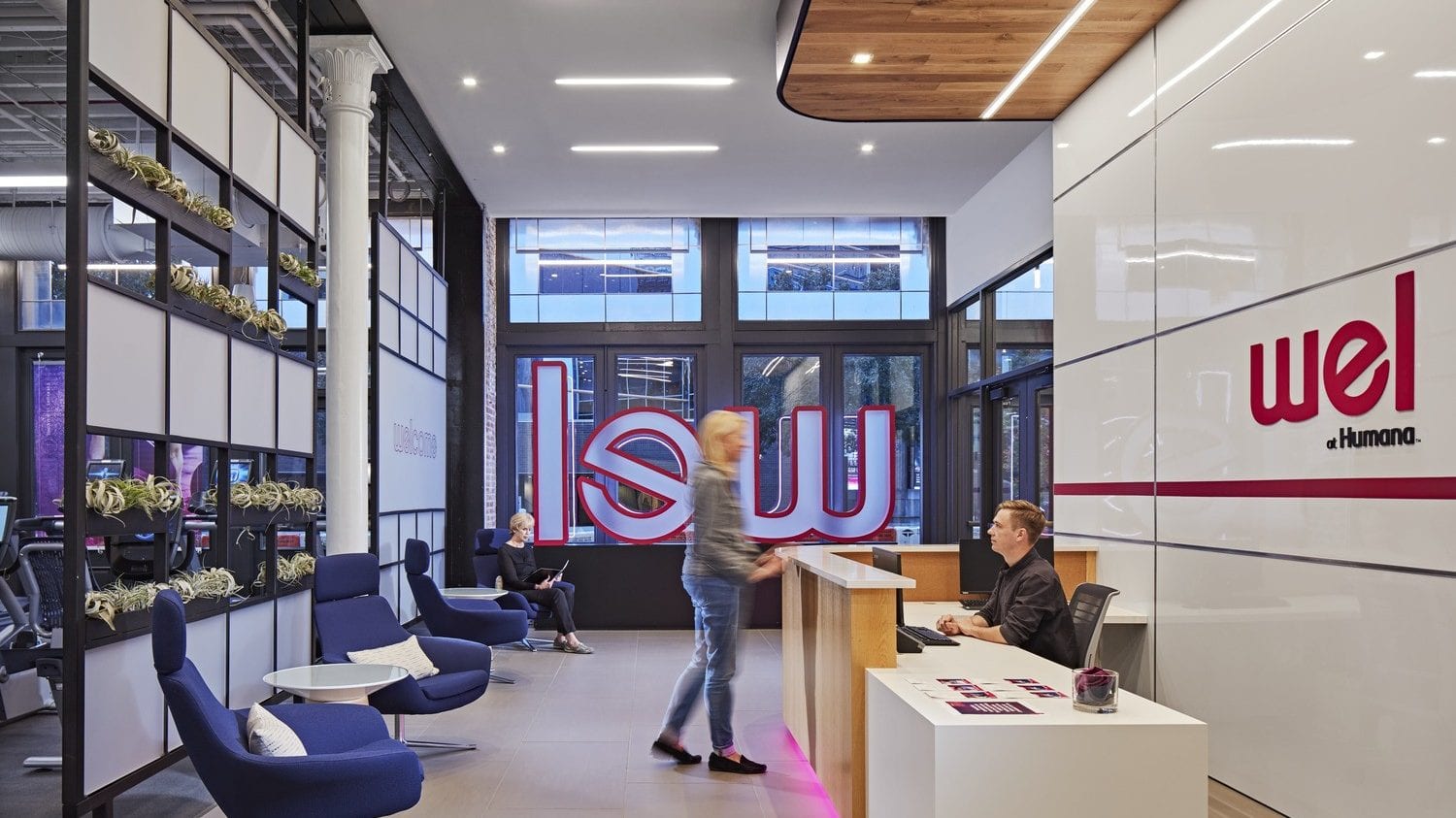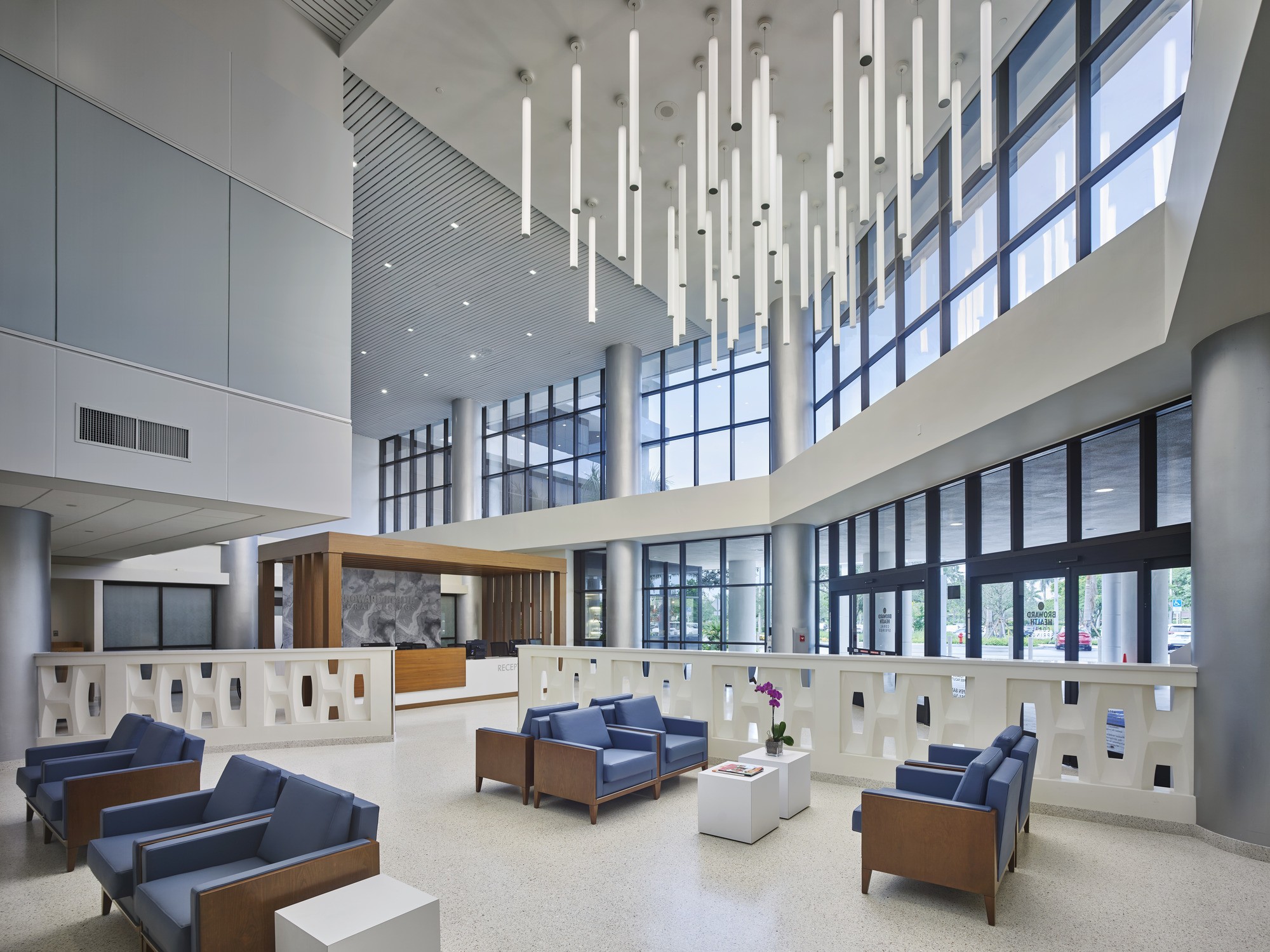By Carol Doering CHID, IIDA, LEED AP | Account Manager
and
Misty Bell NCIDQ, CHID | Senior Designer

The IA-designed space at wel at Humana is an example of a hybrid space that combines many lessons from both healthcare and workplace design. Photography © Tom Harris.
In considering the return to the workplace, designers and workplace experience managers are leaving no stone unturned in the quest for safe and simple solutions. As no organization was perfectly prepared for the outbreak of the novel coronavirus, it makes sense that we would look to other fields to see what benefits might lie in different approaches. While hospitality, retail, and residential design all have been sources of inspiration in this conversation, healthcare has proven to be the most relevant. It can offer workplace designers a number of lessons that will doubtlessly inform how we create the next generation of workplaces. By borrowing these ideas and products, we can make our offices a cleaner and therefore safer place.
An Eye On Material Selection
For years, healthcare design has understood that joint-free and easily-cleaned surfaces are one of the simplest steps designers can take in creating a more hygienic environment. Spurred on by the emergence of the HIV epidemic in the 1980’s and ‘90s, healthcare designers were asked to create interiors that met the aesthetic sensibilities of their clients, but could withstand the 10% bleach solutions that environmental services had resolved to use to clean every surface. While this led to the use of certain vinyls as a practical solution, many alternatives (such as bleach-cleanable fabrics and faux leather) have since come a long way.
Material selection offers designers one of the simplest ways to ensure that the built environment offers clean, safe experiences for users. In this effort, finding smooth, durable surfaces that are joint-free is crucial, but not the only indicator of a sanitary surface. For example, wood is not always a preferred choice as it is porous (as are some metals), and those pores can be difficult to clean and thus play host to a number of harmful viruses and bacteria. This is especially relevant to textured flooring, as recent studies have reinforced. Ultimately, workplaces, like healthcare spaces, will need to be designed to take into consideration how users will use and clean the area. Depending on sanitization methods, different materials, fabrics, and even paints may be the most appropriate choice.

Broward Health, Coral Springs, Fl. Photography © Halkin Mason.
Smart Materials
A significantly newer concept in the world of healthcare design that may be adopted in the workplace is the use of “smart” materials that can effectively sanitize themselves. For example, various surface pad products are available in the market today that can be applied to high-touch surfaces and are engineered to prevent the spread of germs. With each contact, a small amount of alcohol gel is released, killing various bacteria.
For years, researchers have promoted the use of copper due to its antibacterial properties. A study completed by NIH suggests that a 70% copper coating can be extremely effective at killing viruses like MRSA and E.coli. These copper coatings have a variety of applications and can be easily incorporated into the design of light switches, elevator buttons, toilet seats, faucets, etc. These applications create an inherently safer office that can be further supported by stringent cleaning protocols.
Tracking and Automation
Automation in corporate office space is not a new solution and has been commonly applied to items such as building lighting systems. However, healthcare systems on the forefront of this technology are utilizing RFID sensors to monitor employee movement throughout the day. This technology can track where a staff member is in the building as well as time stamps for breaks and activities such as handwashing. While corporations may be reluctant to rely on this technology for reasons of individual privacy, there are several applications the office environment could embrace such as reminding users to stretch, wash their hands or sanitize their desks, and devices.
UV Sterilization
A topic on which we’ve written before, spaces like hospitals, gyms, and hotels have been relying on UV light sterilization as a standard cleaning protocol for some time. That said, only recently have UV sterilization wands, device sterilization cabinets, mobile room sterilization units, etc., been considered for use in workplace settings. It's critically important that designers and end-users are aware of how each of these devices function and whether they're appropriate for the intended use. IA's Director of Lighting Design Gary Bouthillette points to recent claims manufacturers are making regarding their products: "Specifiers and clients should exercise caution when confronted by manufacturers’ claims about their products’ effectiveness, particularly with respect to inactivating viruses like COVID-19. For example, a product that has proven effective against bacteria such as E. coli and Staphylococcus may not be effective against a virus like the one that causes COVID-19."
Circulation and Strategic Layouts
Just as operating rooms utilize different zones (e.g. a sterile zone, anesthesia zone, circulation zone), workplaces will also be considering how they can minimize cross-infection through the strategic configuration of spaces. Similarly, A/B day (or week) scheduling and the distancing of less essential functions from the point of infection have been utilized in healthcare environments to cope with viral outbreaks.
Currently, there is no law requiring a company to provide sick leave to their employees, and often those organizations that do offer it do so on a limited basis. As a result, it has become commonplace for employees to show up at work if they are feeling under the weather. Minor migraines, allergies, and colds are common ailments that people often believe they can “power through” without taking sick leave or vacation days. Office designers can consider this by creating separate spaces for “no contact days.” These areas would be separated entirely from current mother’s rooms or wellness rooms. They would be focused on isolating employees who may be slightly under the weather but still able and willing to come to work. This space would need increased airflow and, if possible, an operable window to reduce the spread of germs to other parts of the office. Easy to clean hard surface floors and walls, cleanable fabrics, and hand sanitizers would be vital in this hypothetical “no contact space.”
Hands-Free Design
If used in conjunction with the proper cleaning protocols, hands-free door and foot levers similar to those in clean environments or ICU units could be a key feature for minimizing the risk of infection in the workplace. According to the Centers for Disease Control and Prevention, studies show nearly 80 percent of illness-causing germs are spread by your hands. Integrating these into restrooms and break rooms is an easy and low-cost solution for existing office space. As designers, we are seeking solutions that are effective but do not compromise our aesthetic sensibilities. Demand is high for these innovations and many new products are entering the marketplace. Only time will tell how well they are received.
Prioritizing Physical and Mental Wellbeing
A few decades ago the healthcare world realized that a change in design methodology was needed to ensure that spaces attended to the physical and mental wellbeing of those who inhabited them. Prior to that time, healthcare interiors were largely colorless, sterile settings with shiny vinyl floors and faceless vinyl furniture, which conveyed the serious nature of the work that was being done. When this shift occurred, the interior designer found a growing role. This allowed the designer to act as a champion for the healing environment as science raced to develop a better understanding of the connection between our environment and health outcomes. Evidence was informing design as testing and learning helped the industry become better champions for patient dignity and support of the staff. Hospitals were facing competition as patients realized they could shop around for their healthcare, and baby boomers were leading the way searching for more spa-like hospitals with atriums, trees, beautiful finishes and elegant furniture. Ultimately, designers started looking at hospitality design as a north star.
Similarly, the workplace, too, should make a shift. While much progress has been made over the past decade, reducing anxiety and establishing a sense of safety should be of paramount importance when considering workplace design. Where healthcare used furniture placement in creating a sense of privacy, similar steps could be taken to enforce social distancing.

Now, moreso than ever, workspaces are placing importance on the mental wellbeing of users. Photography © Riiko-Andre Nuud.
Conclusion
Ultimately, the workplace will be adopting more lessons from the healthcare world than just design methodologies. Training employees to better understand proper cleaning and hygiene methods, for example, could greatly decrease germ sharing. As it stands, those in healthcare are the experts in fighting the transmission of bacteria, germs and viruses. By implementing a few simple, tested methods, and materials, designers can make the return to the office a more comfortable and healthier process.


